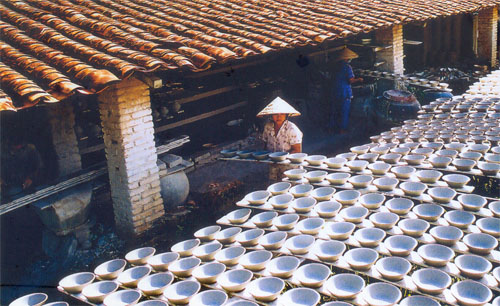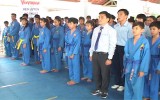Pottery in Lai Thieu and the relation to approximate regions
Update: 09-08-2014 | 10:40:15
Handicraft and pottery as a part of it is the sophisticated products of the mind and civilization built up by the precedent generations for ages. Pottery has become a symbol of Vietnamese culture and characteristics as a cultural legacy.
Handicraft and pottery as a part of it is the sophisticated products of the mind and civilization built up by the precedent generations for ages. Pottery has become a symbol of Vietnamese culture and characteristics as a cultural legacy.
 |
| A collection of Lai Thieu pottery is on display at Binh Duong Provincial Museum. Photo by Nguyen Thi Lan. |
By the 19th century, the Chinese community in Binh Duong Province grew in quantity after moving from Cu lao Pho in Bien Hoa and Ben Nghe in Gia Dinh. The pottery villages emerged in Lai Thieu, Phu Cuong, and Tan Uyen with products boldly transformed in terms of quality.
Up to date, the Chinese communities in Binh Duong Province are still located in their previous locations of Thu Dau Mot City, Lai Thieu, and Tan Phuoc Khanh.
From the beginning, pottery was the colorful cultural features of Binh Duong through times.
In fact, pottery kilns of Chinese communities are accounted for 80% of such kilns in those areas.
Chinese seeking settlement in Vietnam were to avoid catastrophy; thus, they were united in sharing the hardship. Potter required secrets but that would not take them apart. The kilns were erected with not long distance from one another with good relation of the profession and other relationship.
As far as professional relation was concerned, those Chinese communities were engaged in different types of products in different regions.
We could recognize the origin by looking to the products, i.e. in Lai Thieu, they were specialized in big jugs while Chanh Nghia, they were specialized in bowls, catering utensils. In Tan Phuoc Khanh, the pottery products were mainly vases, wine pots, ornament plant pots, etc.
 |
| A worker is arranging pottery products to be dried under the sunlight in Chanh Nghia Ward |
The lines are vague nowadays; however, such distinctive production still holds major role in their current production.
We can explain the difference by referring to the difference of materials. Besides, the then transportation was a great challenge helping them to confine their sales in specific region only.
They also upheld the bloodline to maintain their pottery villages.
As for worshiping, the pottery communities shared the same ancestor worshiping, especially Bon God – the father of local pottery. As it goes as saying, Bon was a man of martial arts helping people to fight robbers. On his death, he became a god helping the poor and people meeting bad luck in life. Thus, Bon God symbolized luck, bringing the communities those good things they needed.
Pottery was considered as a risky career and they set up temple of Bon God; thus, he became the father of pottery.
Annually on the 25th, 26th, and 27th of lunar February, people of pottery villages across Lai Thieu, Chom Sao, Chanh Nghia, and Tan Phuoc Khanh, in turn hold rituals and Bon God Temple set up by Yang and Li families.
On the foundation of ancient civilization and culture of Phu Nam, the Vietnamese as a cultural subject, has aborbed the achievemetns of other people in a few hundred years to create Southern Region-featured pottery where Lai Thieu is a representative.
Reported by Hien Lan – Translated by Vi Bao
 Cultural tourism requires more investment to become cultural industry
Cultural tourism requires more investment to become cultural industry
 Thu Dau Mot city team wins high ranking prize at the second open Tai Tu Music Festival of Thu Duc city
Thu Dau Mot city team wins high ranking prize at the second open Tai Tu Music Festival of Thu Duc city
 Wrestlers dominate regional championships with 29 golds
Wrestlers dominate regional championships with 29 golds
 Special TV shows to mark 70th Liberation Day anniversary of Hanoi
Special TV shows to mark 70th Liberation Day anniversary of Hanoi
 Phase 2 of national troupe festival 2024 gathers vibrant cultural activities
Phase 2 of national troupe festival 2024 gathers vibrant cultural activities
 Nearly 200 union members and workers take part in sports festival of grassroots trade unions
Nearly 200 union members and workers take part in sports festival of grassroots trade unions
 Sports event celebrating the 25th anniversary of Binh Duong Young Entrepreneurs Association: Aiming for professionalism and methodical manner
Sports event celebrating the 25th anniversary of Binh Duong Young Entrepreneurs Association: Aiming for professionalism and methodical manner
 State-funded war film “Peach Blossom, Pho and Piano” to compete at Oscar
State-funded war film “Peach Blossom, Pho and Piano” to compete at Oscar
 Guam coach targets victory against Vietnam at AFC U20 Asian Cup qualifiers
Guam coach targets victory against Vietnam at AFC U20 Asian Cup qualifiers
 Binh Duong on-stage performing arts resilient contributions to tradition promotion
Binh Duong on-stage performing arts resilient contributions to tradition promotion



